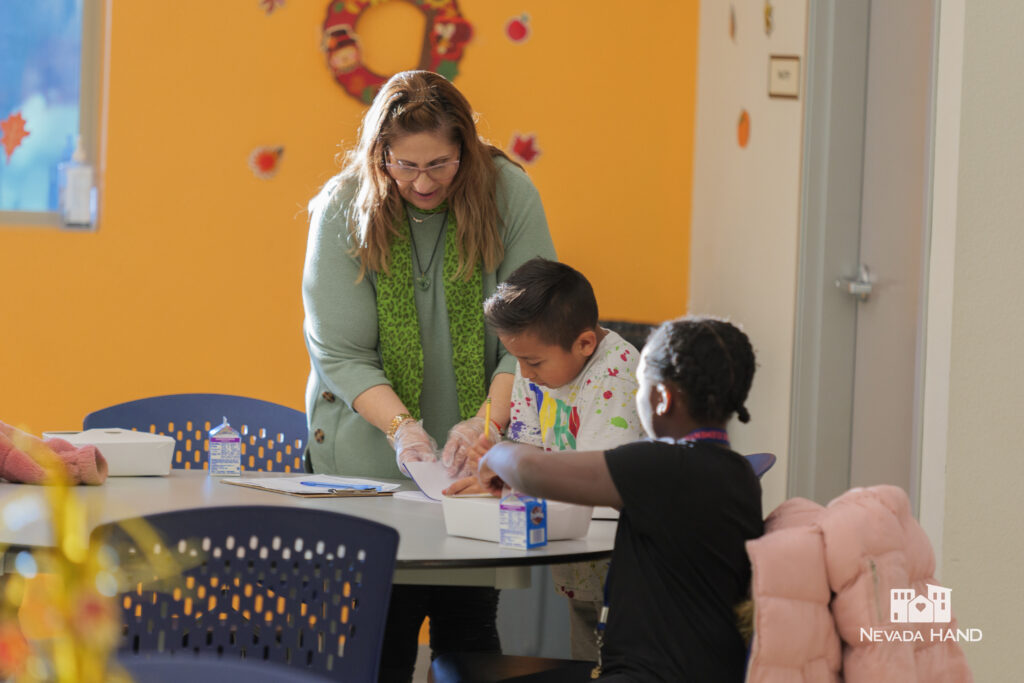
Affordable housing provides a foundation that helps individuals thrive in myriad ways, improving financial stability and self-efficacy, healthcare outcomes, mental and physical well-being, and educational achievement. For school-aged children, the link between stable housing and educational attainment is well documented in literature, and Nevada HAND’s Resident Services team adds year-round enrichment activities and educational programming to the stable housing foundation we provide. This is just one way Nevada HAND offers “more than a home” to residents.
What research tells us about housing and education:
While many factors affect school outcomes among low-income children, including parental involvement and school quality, housing affordability and the physical environment of a child’s home have been found by researchers to strongly influence children’s cognitive abilities (G. Duncan et. Al., 1998; Yeung et al., 2002).
Low-income children in affordable housing score better on cognitive development tests than those in unaffordable housing (Newman & Holupka, 2015). Children’s cognitive achievement declines the most when housing-cost burdens exceed 50% of a family’s income. The most deleterious consequences for children’s cognitive achievement observed by Newman & Holupka (2015) are observed when housing-cost burdens reach 60% or higher. Affordable housing enables parents to spend more disposable income on their children’s enrichment through books, computers, and educational travel, rather than just focusing on necessities like medical care. Recent research has demonstrated that lower-income parents in affordable housing spend more on child enrichment (Newman & Holupka, 2014). Parents are able to save more money for their children’s college tuition and are more likely to attend a parent-teacher conference when they are not rent burdened (Public and Affordable Housing Research Corporation, 2016, quoted from NLIHC, A Place to Call Home.).
The physical environment of a child’s home (often referred to as housing quality) can positively affect children’s safety and health outcomes, leading to better attendance rates and improved attentiveness in class. Living in a housing unit that comfortably accommodates all members of the household provides a stress-free environment in which children can complete homework assignments. In avoiding disruptions at home caused by an unplanned move (e.g., the result of eviction, foreclosure or an unaffordable rent increase), residential stability can lead to an uninterrupted school year and fewer changes that tend to leave children behind academically (Cunningham & MacDonald, 2012). Low-income families generally have high residential mobility rates (Coulton et al, 2009). Residential instability may lead to absenteeism and frequent school changes. Children who change schools frequently lag in reading and math scores by more than a year behind nonmobile students, and half of this difference can be attributed to mobility (Garriss-Hardy & Vrooman 2005). The strongest evidence in academic literature on the role of housing in children’s development links high rates of residential mobility to children’s short-term academic, social, and emotional problems (Leventhal & Newman, 2010).
Beyond affordability and housing quality, neighborhood quality has been found to play a significant role in children’s educational attainment and cognitive development outcomes. In a study of more than five million families in 2015, Raj Chetty and Nathaniel Hendren found that neighborhoods have causal exposure effects on children that carry into adulthood: “every year spent in a better area during childhood increases college attendance rates and earnings in adulthood, so the gains from moving to a better area are larger for children who are younger at the time of the move” (Chetty & Hendren, 2015). This research also shows, after studying 4,604 families over 30 years, that when children under the age of 13 are housed in stable, safe homes in adolescence, their earning outcomes as adults are $3,477 (31%) higher on average relative to a mean of $11,270 in the control group in their mid-twenties (p < 0.05). Children who moved to higher opportunity neighborhoods before they turn 13 are also 16% more likely to attend college and attend better colleges. These children also ended up living in lower-poverty neighborhoods themselves as adults and were less likely to be single parents themselves (for females) (Chetty & Hendren, 2016). For children more than 13 years old when their families move, the opposite is true, and there are negative long-term impacts instead of positive. The duration of exposure to a better environment during childhood is a key determinant of an individual’s long-term outcomes. This underscores the importance of the work that Nevada HAND does to provide long-term, affordable housing to low-income families with children in high-opportunity neighborhoods.
Nevada HAND’s Resident Services education programming is designed to promote lifelong learning for children and adults:
Affordable housing is key to creating household stability, but housing alone does not address all the challenges faced by low-income seniors and families. Sensitive to knowledge generated by decades of research on housing stability, neighborhood effects, and children’s educational attainment, Nevada HAND communities offer “More Than a Home” through supportive, personalized, on-site Resident Services designed around four pillars aligned with the social determinants of healthy communities: Economic Stability, Health and Wellness, Community Engagement, and Education.
The Education Pillar of Resident Services focuses on programs and activities that promote educational attainment, life-long learning, life skills, and healthy choices. For adults, this may include computer skills classes, lunch-and-learn topics ranging from accessing community benefits to managing finances, and legal advice for estate planning for seniors. For school-aged children, Resident Services educational programs target continual engagement and enrichment, including summer activities, after-school academics paired with essential nutrition, community gardening that includes lessons on the science of plants and the food web, and early-childhood project-based learning sessions designed to set children up for a lifetime of educational success.
Anecdotes from our pilot year with i-Ready, a tool to support math and literacy comprehension:
As a member of NeighborWorks, Nevada HAND joined a cohort of fellow affordable housing developers incorporating i-Ready as part of after-school programming in 2022-2023. The i-Ready program is an online platform that offers diagnostic skills testing, personalized learning, and progress monitoring to support students’ math and literacy skills. The use of this platform to extend academic enrichment in after-school programs is particularly impactful for Southern Nevada students, as it mirrors the Clark County School District’s integration of the program in its regular curriculum.
What we observed in the pilot year with i-Ready:
Nevada HAND offered the i-Ready tool as part of existing on-site after-school Resident Services programming, which pairs two essential kinds of support for educational achievement: academic enrichment and nutritious snacks through our “Meet Up and Eat Up” partnership with Three Square. Students completed i-Ready skills diagnostics to understand their learning opportunities and were able to access lessons specifically designed to further their personal achievement. Our qualitative assessments of the program were encouraging: students and families were very interested in and engaged with this addition to our after-school offerings. We look forward to building on this pilot year and learning more about how Nevada HAND’s after-school programming can continue to support students’ academic growth and help reinforce their self-image as empowered, capable, lifelong learners.






